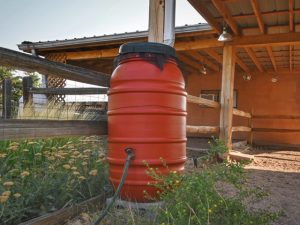Capture what you can
Christine Y. Chavez for the Santa Fe New Mexican
 The main benefit of rain harvesting is that it is a sustainable and workable water practice that is as easy as a simple rain barrel that can be connected to an irrigation system for plants and trees. All that is necessary to take advantage of this resource is to capture the free water falling on your roof and direct it to a rainwater storage tank. By doing this, you can take control of your irrigation water supply, help reduce some of the negative impacts of flooding, and help the City save drinking water for times of drought.
The main benefit of rain harvesting is that it is a sustainable and workable water practice that is as easy as a simple rain barrel that can be connected to an irrigation system for plants and trees. All that is necessary to take advantage of this resource is to capture the free water falling on your roof and direct it to a rainwater storage tank. By doing this, you can take control of your irrigation water supply, help reduce some of the negative impacts of flooding, and help the City save drinking water for times of drought.
The water that collects on your roof and the ground is free and all it takes to harvest that water for your use is a rain barrel or cistern. Rebates for City water customers are available based on each gallon of capacity your rain barrel or cistern holds. By not using City treated water to irrigate, you are reducing the amount of water you are charged for on your monthly water bill. Therefore, rainwater harvesting provides a tremendous opportunity to achieve more water conservation gains at each and every residential and commercial property.
Rainwater harvesting also helps the City’s water utility reduce peak demands during summer months, especially during droughts which saves treated water for more important and appropriate water uses and reduces the amount of groundwater the City has to treat and pump.
Water Harvesting also reduces stormwater runoff and is one of the reasons the City has built raingardens in parks to capture both rainwater and stormwater runoff. The raingardens help improve the quality and quantity of groundwater and reduces soil erosion, stormwater runoff, flooding and pollution of surface water with fertilizers, pesticides, metal and other sediments.
Projections for future precipitation show an increase in high-intensity rain events. Good planning can identify adaptive strategies to infiltrate and harvest rainwater that will help Santa Fe to benefit from large rainfall events instead of being damaged by them.
The City of Santa Fe Water Division and the Santa Fe County Utilities Division are working together to develop community-based strategies for Santa Fe’s water future. 2020 marks the beginning of a science-based, community informed, five-year planning cycle to develop long range water resource management plans.
The first cycle, which began in 2020 and is scheduled to be complete by the end of 2024, will be evaluated, refined, and repeated every 10 years or as necessary in future years. The product of the planning process will be Long Range Water Resources Plans for the City and County.
Understanding that planning for our water future requires the full participation and collaboration of both water managers and water users, the City and County are committed to engaging the broad diversity of area water users and stakeholders in this planning process. This engagement will inform the Five-Year Water Resource Planning Cycle—a roadmap for the planning process—to be completed by the end of 2020. The public will continue to have the opportunity to work with the City and County through the five-year planning cycle to ensure that the final plan responds to their needs and priorities.
Virtual public meetings are currently scheduled as follows:
Introductory Session (same material at both sessions):
Monday October 19th at 10am
Tuesday October 20th at 5:30 pm.
Interactive Break Out Session (same structure at all sessions):
Sunday, 10/25 at 3:30 pm
Monday, 10/26 at 10 am
Thursday, 10/29 at 5:30 pm
Meeting details will be posted soon on https://www.santafenm.gov/water_division
Please visit https://www.savewatersantafe.com to learn more.
